|
|
|
 WHOUY SZE KUINALTH WHOUY SZE KUINALTH
"Teaching Our Many Grandchildren"
|
STATE
STANDARDS
Science
A. A student should understand scientific facts,
concepts, principles, and theories.
B. A student should possess and understand the skills of
scientific inquiry.
C. A student should understand the nature and history of
science.
English/Language Arts
B. A student should be a competent and thoughtful reader,
listener, and viewer of literature, technical materials, and
a variety of other information.
C. A student should be able to identify and select from
multiple strategies in order to complete projects
independently and cooperatively.
CULTURAL
STANDARDS
A. Culturally-knowledgeable students are well grounded in
the cultural heritage and traditions of their community.
B. Culturally-knowledgeable students are able to build on
the knowledge and skills of the local cultural community as
a foundation from which to achieve personal and academic
success throughout life.
C. Culturally-knowledgeable students are able to engage
effectively in learning activities that are based on
traditional ways of knowing and learning.
|
Weather/Climate
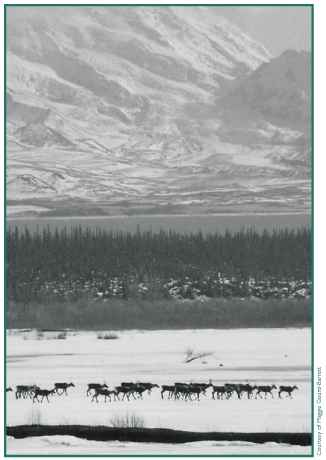
Courtesy of Maggie
Gourd-Barrett
Mount Sanford with caribou
on the Copper River.
|
OBJECTIVES
Students will:
- work with Elders, local experts, and their
teacher to learn about traditional
weather/climate knowledge.
- develop weather watching skills such as;
observing, describing, noticing sequences of
events, patterns, and relationships.
- gain appreciation and understanding of
indigenous and scientific knowledge about the
weather/climate.
|
|
|
Lesson
GRADES K
-12
Activities:
- Work with the Tribal Council to identify and
establish a relationship with Elders, local outdoor
experts ( hunters, trappers, or others who are recognized
as having an expertise in weather changes, patterns, and
signs).
- Schedule a time to visit with the Elder/expert.
- Guide the students in asking questions about their
weather knowledge and how it has contributed to the well
being and local culture of the Village. Perhaps the Elder
has a story to tell on this subject.
- Schedule several meetings with the Elder/expert out
of doors so that specific weather signs, changes,
patterns can be observed by the students.
- Have the students keep a weather journal (written or
recorded) of their visits, observations, and learning.
Younger students may want to convey their learning by
making a poster, song, dance, puppet show, play, or a
video. Each student may discover their "own place" - that
special place that they will return to over the year to
record their observations.
|
 Teacher
Note: Teacher
Note:
Alaska is unique and each region has its own pattern
of weather/climate. The Elders have an intimate knowledge of
their environment, know the variations and nuances in each
weather pattern, and could foretell the weather accurately.
In the past and to a certain extent today, this knowledge
was/is of vital importance to their survival as it allows
them to make decisions on travel, routes, dress, hunting,
fishing, and other subsistence activities.
When we talk of weather we mean what is happening in
the atmosphere today, tomorrow, or even next week. By
Climate we mean weather over time.
|
|
Discussion Ideas:
- Why is it important that we listen and learn from our
Elders or those who are local experts?
- Historically, how did the weather play a role in the
daily lives of our Village? Does weather/climate play a
part in our wellness as individuals or as a
community?
- Is knowing the local weather patterns, changes, and
signs important to our Village today?
- What are the most important things that we have
learned so far about weather?
- Do you have any questions, based upon our current
level of weather understanding, that you would like to
ask the Elders or expert at our next visit?
|
Frost along the Chistochina
River.
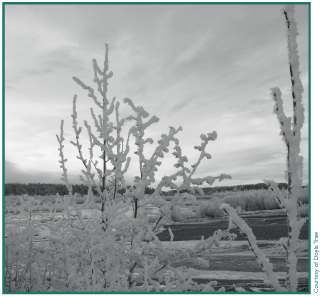
Courtesy of Doyle
Traw
|
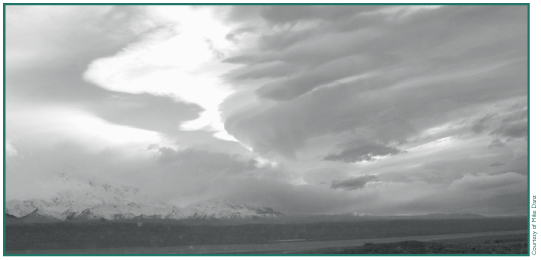
Courtesy of Mike Danz
Orographic stratus clouds.
|
Douglas Neal, Derrick Neal and
Freddy Nicolai, Jr. enjoy a sled ride.

|
Activities:
- Brainstorm with students the purpose of clouds and
the types (sizes, shapes, color, etc) of clouds they have
witnessed/observed.
- Check with a local expert/Elder what the different
types of clouds may mean for local activities (play,
hunting, fishing, travel, animal migrations, and any
subsistence activities).
- Have the students find out the average number of
cloudy days in each month for the local area.
- Have the students record cloud cover over a period of
one month or longer in their observation journals.
- Have students research and set up experiments that
reflect cloud formation and condensation.
- Teacher may wish to read and do follow up writing,
art, or drama activities from the following
suggestions:
Cloudy with a Chance of Meatballs by Judi
Barrett
Nothing Ever Happens on My Block by Ellen
Raskin
Bartholomew and the Oobleck by Dr.
Seuss
The Lorax by Dr. Seuss
Stopping by the Woods on a Snowy Evening by
Robert Frost
Rainbows are Made by Carl Sandburg
|
|
Discussion Ideas:
- Why are clouds important to the Earth and its
populations?
- What have we learned from the Elders about
clouds?
- How would the temperature in our local area be
affected if the number of cloudy days increased or
decreased?
- Do the number of cloudy days differ from season to
season?
- Do clouds affect the activities that we engage
in?
- What weather changes can occur when clouds are
present?
- What elements bring clouds into our local area?
Activities:
- Ask the students to list all forms of liquid
precipitation and solid precipitation that they can think
of.
- Working with the local expert/Elders, find out what
activities occur with differing types of
precipitation.
- Ask the Elders for any stories that deal with
precipitation.
- Older students may wish to research, build, and teach
younger students about the Hydrologic cycle.
- Have the students find out the average amount of
precipitation for the local area.
- Have the students gather data on the daily
precipitation for the local area using a rain gauge. Ask
them to record this data in their observation
journal.
Discussion Ideas:
- What do you think would happen if our annual
precipitation fell in just one month?
- Does precipitation have any influence on our cultural
activities?
- What factors do you think influence when and where
rain falls?
- What is your favorite/least favorite type of
precipitation? Why?
|

Courtesy of Barb
Dalke
Fish Creek near Mentasta
Lake.
|
Activities:
- Students should go out and observe and record their
observations of the wind. They should use all their senses on
their observation and recordings.
- Work with the Elders/local expert to learn the local language
concerning wind and its effects on the environment or
activities.
- Brainstorm with students effects of differing velocities of
wind.
- Ask the Elders/local expert if they have stories to share
concerning the wind.
- Have students draw, paint, write, compose (poetry or song)
about the wind.
- Our wind generally comes from a certain direction, work with
the Elder/local expert about what weather patterns we see when the
winds come from certain directions?
- Students should record general weather patterns and wind
directions over a period of time.
Discussion Ideas:
- What do we mean by "Wind Chill"? How can it effect
us and our activities?
- How can wind be helpful/harmful?
- What purpose does wind have?
- What have we learned from our observations?
- What have we learned from our Elders/local expert?
- What direction does our wind generally come from?
- What weather patterns are generally seen when the wind is from
the SE, SW, NE, NW, S, E, W, N?
Log cache at Batzulnetas.

WIND CHILL
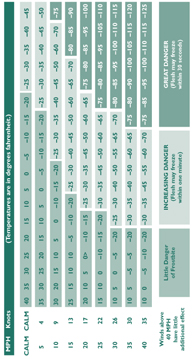
Click on image for a closer view
Activities:
- Using a Maximum/Minimum Thermometer, have students record the
daily temperature. They should pick a reading time which
approximates solar noon. This data should be recorded daily in
their observation journal.
- Working with the Elders/local expert, find out how temperature
affects subsistence and cultural activities.
- Work with the Elders/local experts to understand how, in times
before thermometers, temperature was ascertained.
- Have students research and build a working thermometer.
Compare temperature readings from the student built thermometer to
a commercial thermometer.
Discussion Ideas:
- What activities currently can be safely enjoyed at
temperatures below zero? Above zero? What activities,
historically, were enjoyed at temperatures above zero? Below
zero?
- How did our Elders tell the temperature before
thermometers?
- How did the temperature affect the way our Elders
subsisted?
- How does the temperature influence our lifestyle today?
- What is the average temperature we experience in our local
area in the winter? Fall? Spring? Summer?

Courtesy of National Park
Service
|
 The
University of Alaska Fairbanks is an Affirmative
Action/Equal Opportunity employer, educational
institution, and provider is a part of the University of Alaska
system. Learn more about UA's notice of nondiscrimination. The
University of Alaska Fairbanks is an Affirmative
Action/Equal Opportunity employer, educational
institution, and provider is a part of the University of Alaska
system. Learn more about UA's notice of nondiscrimination.
Alaska Native Knowledge
Network
University of Alaska Fairbanks
PO Box 756730
Fairbanks AK 99775-6730
Phone (907) 474.1902
Fax (907) 474.1957 |
Questions or comments?
Contact ANKN |
|
Last
modified
August 17, 2006
|
|
|